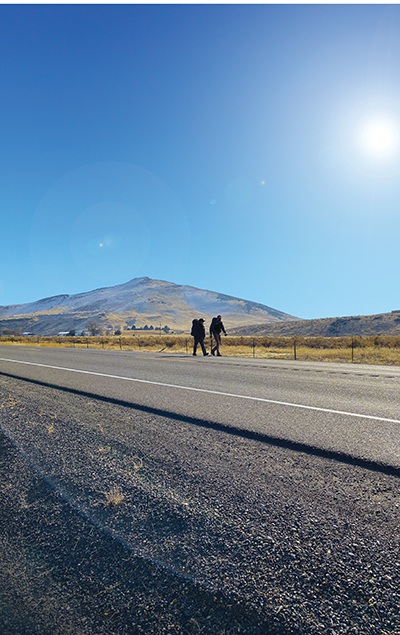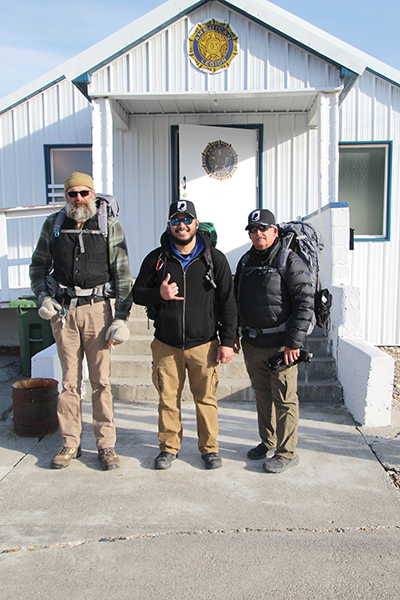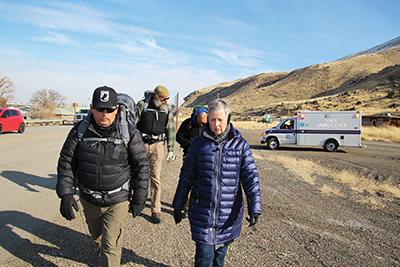 On June 6, 2022, the anniversary of D-Day, highly decorated retired Marines started out on a hike on U.S. Highway 20. This was no ordinary hike. The voyage would take these men from Boston, Mass. — through 11 states and 3,365 miles — to the final stop on our nation’s west coast: Newport, Ore.
On June 6, 2022, the anniversary of D-Day, highly decorated retired Marines started out on a hike on U.S. Highway 20. This was no ordinary hike. The voyage would take these men from Boston, Mass. — through 11 states and 3,365 miles — to the final stop on our nation’s west coast: Newport, Ore.
The “why” is even more impressive — to bring awareness to Prisoners of War and Missing in Action, and to emphasize the importance of continuing search efforts.
The three men call themselves Team Long Road. It includes U.S. Marine Corps veterans Justin “JD” LeHew, Coleman “Rocky” Kinzer, and Ray Shinohara who joined in August. These men served our country, and now that they’re retired from service, they continue to serve by working to make sure all who served are returned home.
Their journey began via the USS Constitution in Boston.
“That was pretty cool because we went on board the USS Constitution to start because we are naval infantry Marines,” said LeHew, chief operating officer of History Flight and 2022-2023 national commander of Legion of Valor. “I requested permission to go ashore for 3,365 miles.”
The decision to walk U.S. Highway 20 is significant for several reasons. The highway is known as America’s longest road, which relates to the long road to bring our POW/MIAs home, the War in Afghanistan and Iraq is America’s longest war and began 20 years ago, portions of the road are known as the POW/MIA Highway, and it’s designated as the Medal of Honor Highway.
“It really just tells the journey of America. It’s America’s grandest highway,” said LeHew. “The bones of America are everywhere across Route 20. We could think of no better highway to be able to walk as Marines.”
Why the search for POW/MIAs is relevant today
You see the POW/MIA flag, you see the empty chair, you see the table setting … but do you ever take the time to really stop and think about what it means? Do you think about the families still waiting for their loved one to return to the United States and finally get the much needed closure?
The Long Road saw these reminders throughout their journey. LeHew points out that in every town across America, large or small, a POW/MIA flag is flying.
“A lot of people, especially in the younger generation, do not know what that means,” he said.
Those who understand the meaning behind the POW/MIA flag may not realize search efforts continue because they think everyone has been brought home and they are buried in military cemeteries. LeHew says that’s not the case.
“When you tell them no, they’re laying underneath pig styes; they’re underneath housing complexes. I have found that every American you tell that to, regardless if they believe they have a military connection or not, is appalled when they hear that.”
Awareness is so important.
“That’s someone’s son, someone’s brother, that’s an American,” said Kinzer, assistant operations manager for History Flight. “They did their part. There’s 81,000, roughly half that are recoverable. The rest are lost at sea. That’s 40,000 — the size of a midsize town — all over battlefields where the U.S. has fought.”
 “Some people may ask the question: Why are we focused on the people from the past who are already dead? Why not on the living? It’s because we’re Americans. We promised every servicemember that we would bring them home. And we were able to do that in the war era that we were in, but in the previous ones, they didn’t have that,” said Shinohara, a retired Marine. “For us to go out there and bring these individuals home, it provides closure for their family.”
“Some people may ask the question: Why are we focused on the people from the past who are already dead? Why not on the living? It’s because we’re Americans. We promised every servicemember that we would bring them home. And we were able to do that in the war era that we were in, but in the previous ones, they didn’t have that,” said Shinohara, a retired Marine. “For us to go out there and bring these individuals home, it provides closure for their family.”
In some cases, the search for a POW/MIA has touched several generations. It may not be their grandchildren or great-grandchildren, but just like their parents before them, they want to bring the remains home.
“Because all of us, regardless of service branch, we all grew up in the military, and we were told we don’t leave our dead or wounded behind,” said LeHew.
“The more I walk, the more I feel connected to this project,” Shinohara said. “The amount of times I’ve been deployed and lost guys, I was able to bring them back home.” Shinohara said being part of Team Long Road has given him the opportunity to be part of leaving no one behind.
Interacting with families along the way
During the voyage, Team Long Road has met families who are still holding out hope for their loved ones to be returned home.
LeHew said the World War II generation still has some living family members who were sons and daughters of these servicemembers, and they are now in their 90s. They keep up the search because they made a promise they would continue to do so. Those sons and daughters are now asking their grandchildren and great-grandchildren to keep going.
“We actually got to meet some of these families. It happens generationally, so the generations suffer from the loss of a member of their family, and they tell the stories of how they missed them,” said Shinohara.
Meeting these families not only personalizes the mission but gives LeHew the opportunity to talk with them about steps they can take to make sure the search continues. LeHew asks the families, “Is your family connected with the DPAA? Have you received the case brief? When’s the last time you received the case brief?”
The Defense POW/MIA Accounting Agency (DPAA) hosts briefings across the country and through livestreams to keep families updated. During these meetings, families are updated on the latest information available on the U.S. government’s worldwide search. They hear from senior officials, scientists, and experts about the mission. The DPAA started these meetings in 1995 and have reached more than 17,000 family members. During the briefings, families also have the opportunity to talk directly with a representative about the search for their family members. You can find a schedule for these meetings at www.DPAA.mil.
Support from The American Legion Family
In November, 2022-2023 ALA National President Vickie Koutz and American Legion National Security Director Mario Marquez, who served in the Marines with LeHew and Kinzer, spent some time with Team Long Road as they were walking in Oregon. Like the trio, Koutz is raising awareness for POW/MIAs.
The Auxiliary’s mission aligns with their mission, particularly this administrative year: Koutz has pledged on National’s behalf to raise awareness for our country’s Prisoners of War and Missing in Action.
 Koutz was grateful to be able to walk with Team Long Road, hear their stories, and learn how The American Legion Family can help. The passion Team Long Road has for bringing home POW/MIAs is infectious. As Koutz hiked with them, she could feel it. The conversations she had with all three men were informative and engaging.
Koutz was grateful to be able to walk with Team Long Road, hear their stories, and learn how The American Legion Family can help. The passion Team Long Road has for bringing home POW/MIAs is infectious. As Koutz hiked with them, she could feel it. The conversations she had with all three men were informative and engaging.
“Words can’t express how much it meant to me,” she said. “I’m going to continue promoting this everywhere I go, to every group I speak to.”
Koutz speaks about POW/MIAs at all ALA visits as national president, but says she now has so much more information to share.
LeHew talked with Koutz about the importance of the Legion Family and similar organizations to keep up efforts to bring these servicemembers home to be a given a proper resting place on U.S. soil.
“More importantly, as those of us, like you and I, who are sitting at the top of organizations and running national programs that have advocacy — that is representation to Congress,” said LeHew. He points out that returning our servicemembers home was part of the charters for many veterans service organizations (VSOs).
History Flight’s mission
Funds raised from The Long Road are supporting the mission of History Flight, a 501(c)(3) nonprofit organization based in Fredericksburg, Va., that assists the DPAA in the search for missing military personnel.
LeHew and Kinzer both work for History Flight. LeHew is chief operating officer, and Kinzer is operation manager and team leader. Kinzer conducts operations in both the European and Pacific theaters of operation.
Since its founding in 2003, History Flight’s researchers and scientists have helped bring home the remains of 160 servicemembers.
The organization has a dedicated team searching for missing-in-action servicemembers from the Battle of Tarawa, remembered as one of the bloodiest battles in the history of the U.S. Marine Corps, killing roughly 1,000 Marines and Sailors and leaving more than 2,000 wounded. You can read more about the organization at www.HistoryFlight.com.
Their work continues
Team Long Road walked across the country to get people talking about the need to bring our POW/MIAs home. Now it’s our turn to continue bringing attention to the 81,000 still unaccounted for. They fought for us. Now we need to fight for them.
Team Long Road’s journey across America was completed in mid-December, but the work continues. The Marines will continue to bring awareness to POW/MIAs and do their part to leave no one behind.
LeHew says his greatest hope is that others out there will continue searching for years to come.
By Jennifer Donovan
About Team Long Road
LeHew, Kinzer, and Shinohara served together in the 3rd Marine Regiment between 2010-2013.
Sgt. Maj. Justin “JD” LeHew served 31 years in the U.S. Marines, serving in combat actions including Operation Desert Storm in 1991, Bosnia-Herzegovina in 1993, and multiple tours during the War on Terror in Iraq between 2003-2010. He earned the Navy Cross for heroism in Iraq in 2003 and was awarded the Bronze Star for Valor in combat action in Iraq in 2004. He is the chief operating officer of History Flight. He is also the 2022-2023 national commander of the Legion of Valor.
Sgt. Maj. Coleman “Rocky” Kinzer retired after serving in the U.S. Marines for 24 years in the infantry and aviation fields and was a drill instructor. He was awarded the Meritorious Service Medal in 2019. He is the assistant operations manager/team leader of History Flight.
Staff Sgt. Ray Shinohara is a retired Marine who served for 11 years. He served in Iraq from 2003 to 2007 and in Afghanistan from 2009 to 2013. After retirement, Shinohara became a social worker.
Legion of Valor
JD LeHew is the 2022-2023 national commander of the Legion of Valor. Founded in 1890, it’s America’s oldest veterans service organization. Members of the organization are recipients of the nation’s two highest honors for valor in combat. These include the Congressional Medal of Honor, the Navy Cross, the Army Distinguished Service Cross, and the Air Force Cross.
Interesting facts
In the spirit of Service, Not Self, the mission of the American Legion Auxiliary is to support The American Legion and to honor the sacrifice of those who serve by enhancing the lives of our veterans, military, and their families, both at home and abroad. For God and Country, we advocate for veterans, educate our citizens, mentor youth, and promote patriotism, good citizenship, peace and security.